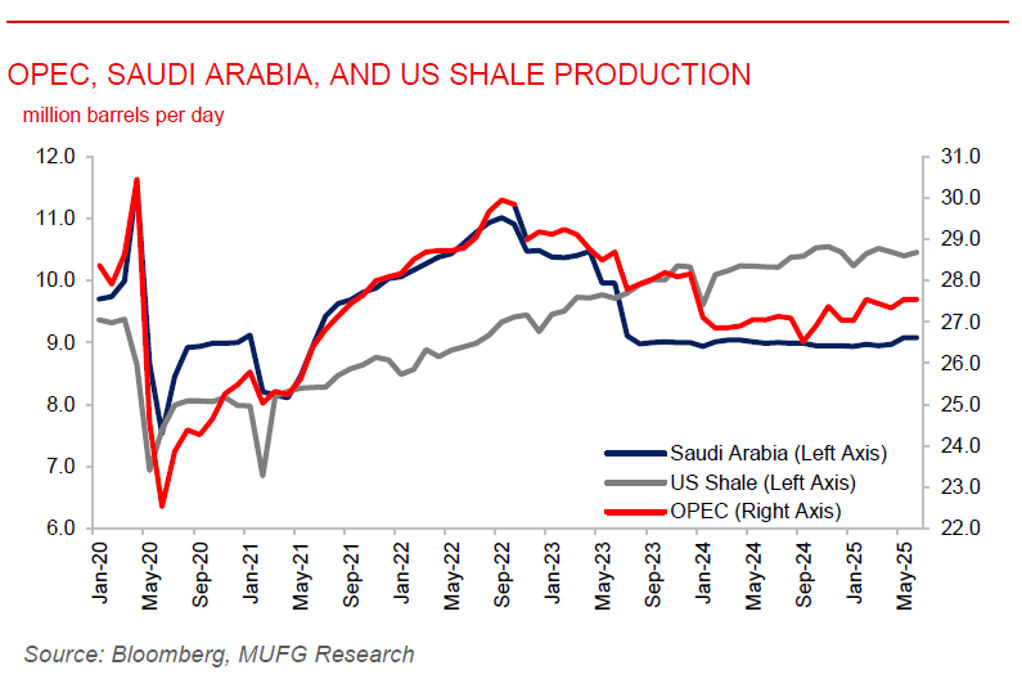To read the full report, please download the PDF above.
Middle East Daily
SOOJIN KIM
Research Analyst
DIFC Branch – Dubai
T: +44(4)387 5031
E: soojin.kim@ae.mufg.jp
MUFG Bank, Ltd. and MUFG Securities plc
A member of MUFG, a global financial group
Middle East Daily
COMMODITIES / ENERGY
Oil holds steady as market weighs Middle East tensions and US stockpile data. Oil prices were little changed on 2 July, with Brent near USD67/b and WTI above USD65/b, as traders balanced renewed Middle East uncertainty with US inventory signals. Iran’s decision to cut communication with UN nuclear inspectors has added fresh ambiguity to regional dynamics, despite signs of a temporary ceasefire agreement between Israel and Gaza. In the US, a reported 1.4 million-barrel drop at Cushing, the largest since January, raised attention ahead of official inventory data, even as national stockpiles ticked higher. Crude futures trading has quieted since recent geopolitical spikes, with focus now shifting back to fundamentals, including a possible OPEC+ output hike this weekend and concerns about oversupply later this year.
Saudi Arabia leads surge in Middle East oil export. Saudi Arabia, along with Kuwait and the UAE, ramped up crude exports to 11.9mb/d in June, the highest level since April 2023, as the trio appeared to accelerate shipments amid regional tensions and ahead of an expected OPEC+ supply boost. Saudi exports alone jumped by 441,000b/d to 6.36 million, despite rising domestic use due to extreme summer heat. The export surge likely reflects a strategic push to move barrels while shipping route remained stable under a fragile Israel-Iran ceasefire. With OPEC+ already approving three consecutive 411,000b/d month hikes, the group will meet this weekend to consider a fourth for August. The shift from years of supply restraint to aggressive increase marks a bold pivot by Saudi Arabia, possibly aimed at regaining market share lost to rivals like US shale.
MIDDLE EAST - CREDIT TRADING
End of day comment – 01 July 2025. Very strong day. London walked in with UST materially higher than Monday London close, so prices adapted to the right. You'd normally expect some spread widening in such a pronounced rates move but spreads opened anywhere from +1bp/unch. Bids got tested but held. Client flows were slightly tilted to buying too. Then as UST sold off cash more or less stayed unchanged and furthermore buying flows outnumbered selling flows on mainly ETF inflows. As a result spreads are going out 5bp tighter in IG. Long end bonds had a deep and sticky bid, take ADGB 70s trading and closing around 54.625 (+0.75pt/-5bp) or QATAR 50s closing around 85.25 (+0.75pt/-5bp). In the high beta space MOROC continues to outperform with buyers in the belly 32s and 33s, 33s closing +0.5pt/-10bp. OMAN once again had a quieter day but bids in the long end where about 0.5pt higher/ -3bp. Financials had mixed interest across names but in general buyers of short end against sellers of 5y, but most names going out about -5bp on average. Corps were quieter with some morning interest in DPWDU 33s closing +0.25pt/-5bp. It seems the market is back at buying long end bonds after the rebalancing flows from yesterday. The extent of spread tightening is a bit surprising given balanced flows lately. That said long end remains cheap on RV basis with belly bonds. The big beautiful bill and upcoming data might change the picture, but that is for tomorrow.
MIDDLE EAST - MACRO / MARKETS
Saudi OTC bond trading gains momentum as market reforms attract foreign interest. Saudi Arabia saw a jump in debt market activity in June, with SAR2bn (USD533 million) traded over-the-counter (OTC) following the launch of a new settlement option for sovereign riyal bonds, aimed at deepening capital markets and attracting foreign investors. OTC trades lifted total bond market turnover to SAR5.2bn, above the year’s monthly average, with foreign investors involved in over 80% of OTC deals, according to Tadawul. The reform supports Crown Prince Mohammed bin Salman’s push for more sophisticated financial markets, alongside efforts to expand IPOs and attract high-frequency traders. The Capital Market Authority is also considering tax easing for local corporate bonds, which are gaining visibility after being added to key emerging market indices. While progress is evident, S&P Global noted that liquidity and foreign participation remain limited, though recent reforms and the new investment law are seen as positive steps forward.
IMF approves USD700 million for Jordan’s economic resilience. The IMF completed the third review of Jordan’s Extended Fund Facility (EFF) and approved a new 30-month Resilience and Sustainability Facility (RSF) totalling around USD700 million to support long-term reform. Jordan has demonstrated strong commitment to macroeconomic stability and structural reform despite regional conflicts and global uncertainty. Growth exceeded expectation in 2024 and is projected to strengthen, while inflation remains low and reserves are adequate. The government is pursuing gradual fiscal consolidation, improving public utility finances, and promoting inclusive private sector growth.

